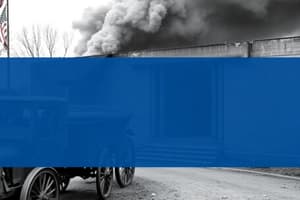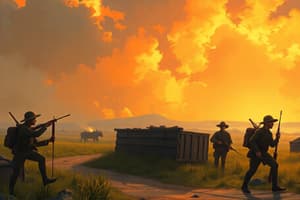Podcast
Questions and Answers
What significant event occurred on November 9, 1918?
What significant event occurred on November 9, 1918?
- Germany invaded neighboring countries
- The Kaiser resigned and fled (correct)
- Germany won the war
- An agreement was signed with the Allies
What form of government was established in Germany after the Kaiser resigned?
What form of government was established in Germany after the Kaiser resigned?
- Monarchy
- Dictatorship
- Communism
- Republic (correct)
When did the new German government sign the armistice?
When did the new German government sign the armistice?
- November 12, 1918
- November 9, 1918
- November 10, 1918
- November 11, 1918 (correct)
What did the Germans hope for by establishing a democratic government?
What did the Germans hope for by establishing a democratic government?
What misconception about the war's outcome is highlighted regarding Germany?
What misconception about the war's outcome is highlighted regarding Germany?
What concept did Wilson emphasize as beneficial for post-war Europe?
What concept did Wilson emphasize as beneficial for post-war Europe?
Which of the following was NOT one of Wilson's 14 Points?
Which of the following was NOT one of Wilson's 14 Points?
What was Wilson's vision of 'peace without victory' intended to achieve?
What was Wilson's vision of 'peace without victory' intended to achieve?
How did Wilson's 14 Points aim to encourage the German surrender?
How did Wilson's 14 Points aim to encourage the German surrender?
Which of the following was a key component of Wilson's vision for a peaceful Europe?
Which of the following was a key component of Wilson's vision for a peaceful Europe?
What was a significant outcome of the Treaty of Versailles regarding Germany's military?
What was a significant outcome of the Treaty of Versailles regarding Germany's military?
Which countries were part of the 'Big Four' during the negotiations of the Treaty of Versailles?
Which countries were part of the 'Big Four' during the negotiations of the Treaty of Versailles?
What was the War Guilt Clause in the Treaty of Versailles?
What was the War Guilt Clause in the Treaty of Versailles?
How did the Treaty of Versailles impact Germany's economy?
How did the Treaty of Versailles impact Germany's economy?
Which of the following was not a major component of the Treaty of Versailles?
Which of the following was not a major component of the Treaty of Versailles?
What was Wilson's 14 Points speech designed to achieve?
What was Wilson's 14 Points speech designed to achieve?
Which of the following was NOT a cause of American involvement in World War I?
Which of the following was NOT a cause of American involvement in World War I?
Why did the Germans ultimately sign the armistice in 1918?
Why did the Germans ultimately sign the armistice in 1918?
What was a primary reason Wilson's 14 Points were not fully reflected in the Treaty of Versailles?
What was a primary reason Wilson's 14 Points were not fully reflected in the Treaty of Versailles?
Who were known as the Big Four at the Paris Peace Conference?
Who were known as the Big Four at the Paris Peace Conference?
What was one of the key factors that led to the US entering World War I?
What was one of the key factors that led to the US entering World War I?
What incident specifically angered the US and influenced its decision to enter the war?
What incident specifically angered the US and influenced its decision to enter the war?
What did the Zimmerman telegram propose to Mexico?
What did the Zimmerman telegram propose to Mexico?
When did the United States actually send troops to join the fighting in the war?
When did the United States actually send troops to join the fighting in the war?
What role did financial aid play in the US involvement in World War I?
What role did financial aid play in the US involvement in World War I?
Flashcards
Unrestricted Submarine Warfare
Unrestricted Submarine Warfare
The act of Germany sinking ships without warning, including passenger vessels. This angered the US as it violated the freedom of the seas.
Sinking of the Lusitania
Sinking of the Lusitania
A 1915 event where a German U-boat torpedoed and sank a British passenger liner, killing over 100 Americans. This incident fueled public outrage against Germany.
Zimmerman Telegram
Zimmerman Telegram
A secret diplomatic message sent by Germany to Mexico during World War I, proposing an alliance in exchange for Mexico reclaiming lost territory from the US. The US intercepted this telegram, leading to a public outcry and increasing war sentiment.
Triggers of US Involvement in WWI
Triggers of US Involvement in WWI
Signup and view all the flashcards
US Entry into WWI
US Entry into WWI
Signup and view all the flashcards
What is an Armistice?
What is an Armistice?
Signup and view all the flashcards
What were Wilson's 14 Points?
What were Wilson's 14 Points?
Signup and view all the flashcards
What is a "peace without victory"?
What is a "peace without victory"?
Signup and view all the flashcards
Who were the Big Four?
Who were the Big Four?
Signup and view all the flashcards
What was the Treaty of Versailles?
What was the Treaty of Versailles?
Signup and view all the flashcards
Wilson's 14 Points
Wilson's 14 Points
Signup and view all the flashcards
Peace Without Victory
Peace Without Victory
Signup and view all the flashcards
Self-determination
Self-determination
Signup and view all the flashcards
League of Nations
League of Nations
Signup and view all the flashcards
Freedom of the Seas
Freedom of the Seas
Signup and view all the flashcards
Armistice
Armistice
Signup and view all the flashcards
New German Government
New German Government
Signup and view all the flashcards
Kaiser's Resignation
Kaiser's Resignation
Signup and view all the flashcards
Republic
Republic
Signup and view all the flashcards
German Belief in Allied Leniency
German Belief in Allied Leniency
Signup and view all the flashcards
Treaty of Versailles
Treaty of Versailles
Signup and view all the flashcards
Big Four
Big Four
Signup and view all the flashcards
Reparations in Treaty of Versailles
Reparations in Treaty of Versailles
Signup and view all the flashcards
German Military Restrictions
German Military Restrictions
Signup and view all the flashcards
War Guilt Clause
War Guilt Clause
Signup and view all the flashcards
Study Notes
American Entrance to World War I
- The war had raged for three years before the United States entered the conflict.
- The United States had supported the Allies with financial and military aid during the war.
- The conflict continued until the summer of 1918.
- The United States did not send troops.
- The United States was influenced by British propaganda and German unrestricted submarine warfare.
- The German sinking of the passenger ship Lusitania angered Americans.
- The Zimmerman telegram prompted the U.S. declaration of war.
- The Zimmerman telegram was a message from Germany to Mexico, attempting to entice Mexico to enter the war to take U.S. territory in the southwestern region.
Studying That Suits You
Use AI to generate personalized quizzes and flashcards to suit your learning preferences.




